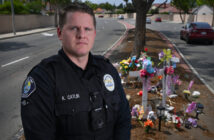The three men gathered at Outback Steakhouse represent three generations of La Palma Police detectives.
The reason for the gathering: the horrific killing of Annie Ross, 31, who was sodomized and then choked to death in her apartment more than 40 years ago.

La Palma detectives never gave up searching for the killer of Patricia “Annie” Ross, shown here in her mid-20s and as a girl.
Photo courtesy of La Palma PD
It was La Palma’s only unsolved killing — until earlier this year.
“You stuck with it all this time,” said Vince Giampa, who retired as La Palma’s Chief of Police in 2004. “To have to live with the fact that I was the responsible investigator from the get go and I didn’t even get close to solving it… I can’t thank you enough.”
Giampa was talking to Ret. Capt. Jim Engen and Det. Paul Bracciodeta.
The case topped Giampa’s list of unfinished business, and he peppered his former colleagues with questions about how they solved the city’s most notorious and vexing crime.
“It started with you,” Engen told his former boss. “You did a great job. We didn’t have DNA back then and you gathered and preserved so much valuable evidence.”
What became clear during the conversation between Giampa, Engen and Bracciodeta: identifying a suspect and building a case required more than some DNA.
Figuring out who the alleged killer was and what his motive might be required ingenuity, creativity, strategy, asking the right questions and poring over evidence, some of it decades old.
Over top sirloin, prime rib and rib eye steaks, the men recalled various investigative techniques, theories, roadblocks and puzzles.
Could the killer have been the man with whom Ross had been casually dating, who told Giampa the cut over his eye and bloody shirt came from an elbow during a pick-up basketball game?
His alibi checked out.
What about the orthopedic resident who Ross also dated who had later refused to provide a DNA sample?
Detectives ultimately got one, and he wasn’t a match.
Giampa recalled the day of the killing — Dec. 11, 1974 — and reminded his colleagues that he knew Ross.
At 2.2 square miles, La Palma is a small town where homicides are rare, about one every three years.
Ross owned a boutique shop, Annie’s Greenthings, where Giampa’s wife bought plants.
What Giampa recalled most vividly about the crime scene was a whimpering dog, who, Giampa believed, had been stuffed in the top dresser drawer by Ross’ killer.
Giampa spent months on the case, leaving behind three white evidence boxes filled with names and copious details from the 53 people who were interviewed; there were stacks of fingerprints, coroner’s reports and four envelopes with blood, possibly scratches caused by the tiny mutt.
Within a year, the case had grown cold.
Jim Engen was only 9 years old when Ross was killed.
It was another decade before Engen took Giampa’s class at Fullerton College’s Police Academy and another few years before he joined Giampa in La Palma.

Jim Engen, now a captain at the La Palma PD, was challenged by his then-sergeant in the detective unit to solve the murder of Ross when Engen became a detective in the mid-’90s. Photo by Steven Georges/Behind the Badge OC
In the mid-’90s, DNA evidence captured Engen’s imagination just as he rotated into detectives.
His supervisor challenged him to solve the Ross killing.
Engen worked with the Orange County Sheriff’s Crime Lab to extract DNA from blood found on Ross’ comforter and a window, but by the time he rotated out he had yet to find a match or identify the suspect.
The case wore on him, just as it had on Giampa.
On his last day on the job, Giampa, in one of his final acts as chief, visited the detectives bureau, and made an impassioned plea:
“Steak dinner for whoever solves this case.”
Flash forward another half decade, to 2007, and Engen, then a sergeant, issued the same challenge to Bracciodeta, then a detective, that his boss had issued a decade earlier.

La Palma Police Det. Paul Bracciodieta wasn’t even born with Ross was brutally slain. Photo by Steven Georges/Behind the Badge OC
The name of the killer, they figured, was inside those evidence boxes. They just needed to run the DNA of all the 53 people against the DNA found at the scene.
Larry Stephens wasn’t even on their radar.
His name was in the box, as somebody who was friends with one of Ross’ neighbors.
But his last name was misspelled: Stevens.
The detectives interviewed the witnesses again.
Ross’ former neighbor, Paul Williams, told the detectives in 2009 that he hadn’t seen his friend, “Larry Stevens,” since shortly after the killing.
But he gave them the clue that changed everything, telling them he had attended Excelsior High School in Norwalk.
That led Engen to Classmates.com and up popped a photo of Larry Stephens.
They figured out his date of birth and discovered two arrests for domestic violence.
One of the reports said he choked his then wife.
Detectives put a picture of his ex-wife next to a picture of Ross. “They look alike,” Engen said.
Stephens became the prime suspect.
In May 2016, after Stephens was arrested for domestic violence yet again, the detectives got a DNA hit that led to his arrest.

Larry Clark Stephens is suspected of killing Patricia “Annie” Ross in 1974.
Photo provided by La Palma PD
He is expected in court in early October.
The detectives have remained in contact with Ross’ relatives, in Arizona. They said they plan to visit for a memorial service after the trial.
They invited Giampa to join.
“I’m so proud of you guys,” Giampa said. “This case was at the top of my list of unfinished business. You did one heckuva job. I’m also really happy for Annie’s family. I hope this brings them some peace.”
 Behind the Badge
Behind the Badge





